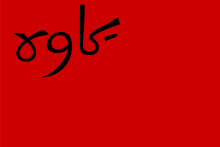Soviet Socialist Republic of Iran
The Soviet Socialist Republic of Iran ( SSRI , Persian جمهوری شوروی سوسیالیستی ایران, DMG Ǧumhūri-ye Šūravi-ye-ye Sosiālisti Īrān ), also known as the Soviet Republic of Gilan , was a 1920-1921 in the northern Iranian province of Gilan established Soviet Republic on the Caspian Sea .
prehistory
During the constitutional revolution (1905–1911) the first Persian translation of the Communist Manifesto was published in Rasht in 1909 . The Jangali rebels of Mirza Kutschak Khan , who had already participated in the constitutional revolution, had been operating in northern Iran since 1914 . With German and Ottoman help, he drove out the troops of Tsarist Russia and disarmed units of the Persian Cossack Brigade built by Tsarist officers .
Kutschek Khan ruled all of Gilan with 3,000 Jangali until 1917, after the outbreak of the October Revolution the retreating Russians gave the Jangali their weapons on the instructions of the Bolsheviks . In addition to Kutschek Khan, an anarchist wing around Ehshanollah Khan emerged within the Jangali .
The British, who supported the anti-Soviet White Army under General Denikin , wanted to secure the oil fields around Baku. General Lionel Dunsterville and his Dunsterforce defeated the Jangali in 1918. Kutschek Khan then submitted to the British, but not to the central government in Tehran. When Iran became a staging area against Soviet Russia in 1919 after the Anglo-Iranian treaty (1919) with Great Britain , the British concluded a non-aggression agreement with Kutschek Khan.
Republican counter-government in Gilan
With the counterattack of the Red Army , there was an anti-British uprising in Northern Iran in 1920, the result of an export of revolution with the active assistance of Yakov Bljumkin . The Soviets pursued the Russian White Guards as far as Gilan and occupied Anzali , where Dunsterville and Denikin had withdrawn. In June 1920 the Communist Party of Iran (later the Tudeh Party ) was founded under the left-wing extremist party leader Jafar Pischewari and the socialist general secretary Agayev. A united front made up of Jangali and the CP captured Rasht (and Mazandaran ) with Soviet help on June 5, 1920 and proclaimed the Persian Soviet Socialist Republic , based on the Bolshevik Caspifleet and 2000 Red Army soldiers under a Soviet military governor. In addition, an Iranian Red Army was formed, the commander of which was Ehshanollah Khan.
After the withdrawal of the Soviets, Ehshanollah, with the help of Pischevari, headed the revolutionary government on July 21, 1920, and undertook adventurous advances against Tehran , which led to heavy losses. In return, the Persian Cossack Brigade, initially dismantled by the Red Army but rebuilt by the British, occupied Rasht at the end of 1920.
In exile in Baku , the Communist Party split after Pischevari was replaced by the Soviets with the former Social Democrat Haidar Khan Amu Ogli . It was not until May 1921 that Ehshanollah, Kutschek Khan and Haidar Khan concluded a new united front . In June 1921, Ehshanollah and 2000 men again marched against Tehran, but they were defeated and the most powerful parts of the Iranian Red Army were finally destroyed.
The Revolutionary Council then excluded Ehshanollah on July 30, 1921, and on August 4, Kustschek Khan and Haidar Khan were able to set up another Soviet system in Rasht. Kutschek Khan tried to forestall the counterattack by government troops by means of a coup and the murder of Haidar. But Reza Khan , who later became Reza Shah Pahlavi, at that time commander in chief of the Persian Cossack brigade, turned down the offer of surrender linked to the guarantee of autonomy for Gilan. On November 2, 1921, Rasht fell for good. Mirza Kutschak Khan was caught half frozen to death, brought to Rasht and beheaded on December 2, 1921. His severed head was brought to Tehran as evidence of his death and handed over to Reza Khan on December 10, 1921.
Autonomy movement in Āzarbāydschān
On April 7, 1920, the Soviet Red Army also marched into Iranian Azerbaijan (Āzarbāydschān), where another Soviet republic was constituted on June 23, 1920 in Tabriz , the Democratic Republic of Āzarbāydschān . However, it did not survive the withdrawal of the Soviets and was destroyed by government troops on September 14, 1920, and its leaders were executed.
Khlebnikov and Esenin in the Soviet republic of Gilan
From April to August 1921 Velimir Khlebnikov toured the Soviet Republic of Iran; he worked in the Red Army as a lecturer and was supposed to teach the children of the Khan in Gilan. A cycle of poems emerged from this journey. Sergei Jessenin was also on the road in the Soviet Republic, he was with his friend Primakov in the troop headquarters.
literature
- Schapour Ravasani: Soviet Republic of Gilan: the socialist movement in Iran since the end of the 19th century until 1922 , Basis-Verlag, Berlin 1980.
- Jana Forsmann: Test case for the "Big Three": The occupation of Iran by the British, Soviets and Americans 1941–1946 (= Dresden historical studies; Vol. 10). Böhlau, Cologne / Weimar 2009 ( Google Books ).
- Gerhard Endress : Islam in data . CH Beck, Munich 2006, ISBN 3-406-54096-1 ( Google Books ).
- Mehdi Parvizi Amineh : Global Capitalist Expansion and Iran: A Study of Iranian Political Economy (1500–1980). Lit Verlag, Münster 1999, ISBN 3-825-84440-4 ( Google Books ).
- Hans-Georg Ebert, Henner Fürtig , Hans-Georg Müller: The Islamic Republic of Iran. Historical origin - economic basics - constitutional structure. Edited by Günter Barthel, Akademie Verlag, Berlin 1987.
- Chosroe Chaqueri: The Soviet Socialist Republic of Iran 1920–1921 , University of Pittsburg Press, 1995.
Individual evidence
- ↑ Cosroe Chaqueri: The Soviet Socialist Republic of Iran. 1995, p. 363.



